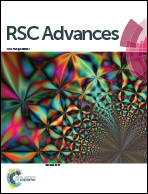Roll-to-roll processed, highly conductive, and flexible aluminum (Al) electrodes based on Al precursor inks†
Abstract
In this study, a roll-to-roll (R2R) process for the large-scale fabrication of aluminum thin films on flexible polyimide (PI) films is proposed. The R2R machine for Al-film coating assembled in the current work uses a previously reported Al etherate-based precursor ink as the source. After the PI substrate is exposed to a diluted catalyst, the Al precursor ink is coated directly on to the substrate by a slit-die coating method. To optimize the injection of the Al precursor ink, a low-flow limit was established. At a film speed of 5 cm s−1, the width of the fabricated Al film was 130 mm. Such Al-coated films exhibit many advantageous features, including 5.87 × 106 S m−1 of high electrical conductivity at 60.9 nm film thickness and high durability with good adhesion. There was only a minor change in the resistance of the film when it was heated at 100 °C in an oven for 10 days or when it was exposed to H2O or ethyl alcohol. Flexibility and tape testing was also conducted and the film showed robustness in both cases. Touch panels (7 cm × 9 cm) were fabricated using the fabricated Al-coated film as one side of the panel; the panel showed enough sensitivity to write recognizable letters on the computer. This indicates that the fabricated Al films can be applied in actual electronic devices without further complicated processing.



 Please wait while we load your content...
Please wait while we load your content...